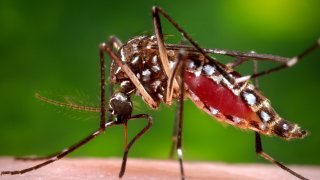
It seems like the plot of a ripped-from-the-headlines episode of "TheTwilight Zone":
A pandemic hits, then people shut themselves away inside homes and businesses. In Act 2, a heat wave rolls in, and, with it, rolling blackouts. In the final act, too hot to stay indoors, people wander outside, where, in the dark, lurks another invisible pest. And the Easter egg lying in wait as the credits roll? The bugs attack in daylight too!
Ok, maybe we're being a little dramatic, but some are saying that there are MOSQUITOES in San Diego this year, and they're really biting.
"I'm being eaten alive," said Grace Ramos of Mission Hills, where there is a very active thread on NextDoor dedicated to the topic. "It's worse this year; however, it's been bad for us the past two years."
While there are those who suspect there is a bumper crop of the bugs this year -- and fears of a looming spike in West Nile Virus cases -- the reality is likely more irritant than pestilent.
Sadly, an elderly Los Angeles resident's death has been attributed this year to West Nile. And, over the weekend, local health officials reported that a 61-year-old hospitalized Alpine man tested positive for West Nile, though it's believed he contracted the virus in Yuma, Arizona.
So what's different in 2020 (besides everything)? Vector Control has, despite the pandemic, been doing all the things it normally does to suppress the mosquito population, like spraying and handing out mosquito-eating fish.
Local
However, Chris Conlan, the supervising vector ecologist at the San Diego County Department of Environmental Health, says the blame for this year's bug bites possibly lies with an invasive species of mosquito, Aedes aegypti, that was first detected in San Diego County in 2014. While Aedes originally called Africa home, it has now spread worldwide due to its love of both people and temperate zones. For the most part, though, the critters have shied away from America's Finest City.
"They've been on our doorstep for a long time," Conlan told NBC 7 by phone. "They've been just to our south in Mexico and just to our east in Arizona, so why they all of a sudden decide to infiltrate San Diego, Los Angeles and Southern California over the past few years is a bit of a mystery."
The thing about Aedes is it likes to feed on people and its larvae can survive in VERY small amounts of water -- even "a bottle cap if sprinklers hit it every day," according to Conlan. So if you've got lots of plants in pots in the yard with saucers under them, you've got a great breeding ground for Aedes.
"The most important consideration with Aedes is that they breed in small container-type sources that are commonly encountered in many backyards, so it's not hard for them to set up shop," Conlan said. "So it's imperative to check properties for standing water and eliminate it…. They don't fly very far -- 300 feet or so -- so eliminating sources in yours and neighboring yards can reduce the problem significantly."
That said, the thing about Aedes, unlike its home-grown counterpart, the Culex mosquito, is that it's not shy about putting in an appearance in the daytime.
And that may be a contributing factor to why the bugs just may seem worse this year.
"They were biting even in the morning and in the middle of the day," Ramos said. "I'd be sitting at the dining room table working and I'd get bit."
Have no fear, though -- ok, have a LITTLE fear: Aedes does not typically transmit the West Nile Virus, Conlan said. West Nile usually infects a person after a mosquito bites a bird carrying WNV, and since Aedes prefers to bite people, it's less likely they will feast on feathered prey and will more likely they will focus on a flip-flop wearer. And even if Aedes does bite a bird, it still may not infect a human with West Nile.
"Aedes is not as competent a vector, and what I mean by that is when an Aedes mosquito happens to bite an organism that has West Nile, it's not as efficient at transferring that disease to the next thing it bites," Conlan said. "The Culex species is better at that."
So is it a particularly bad year for Aedes? Maybe, maybe not, says San Diego County communications specialist Gig Conaughton: "[We're] not seeing more Aedes mosquitoes this year than last -- however, there is a caveat to that: The Aedes mosquitoes are more urban in nature, and Vector Control doesn’t do a lot of trapping for mosquitoes on people’s private properties."
And how about West Nile?
"It's far enough into the season that it's less likely that we'll have a bad year for West Nile," Conlan said.
Most people who get West Nile do not die, of course; 2 in 10 who do contract it experience fever, fatigue and muscle soreness, though. So far this year, there have been 18 cases of West Nile in the state, according to the California Mosquito-borne Virus Surveillance and Response program, most of them in Stanislaus County.



